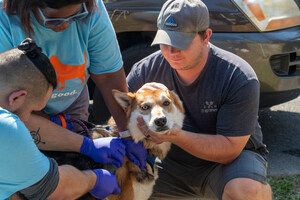New data from Banfield Pet Hospital uncovers breeds and states with the highest and lowest cases
VANCOUVER, Wash., Feb. 16, 2024 /PRNewswire/ -- This National Pet Dental Health Month, Banfield Pet Hospital – the nation's leading provider of preventive veterinary care and part of the Mars Veterinary Health family of practices – analyzed its data from more than 3 million pets seen at its 1,000+ hospital locations nationwide to gain insights on the state of pet dental health across the U.S., including breeds and states with the highest and lowest cases of oral health-related issues.
Dental disease in pets is about so much more than bad breath – and a lot more common than most owners realize. In 2023, 73% of dogs and 64% of cats seen at Banfield were diagnosed with dental-related issues.
Poor oral health can be associated with pain, excessive drooling, bleeding, and reluctance to eat or drink. Periodontal disease, a more serious form of dental disease in pets, may also be linked to other chronic and systemic health problems in the rest of the body, including heart and kidney disease. Research based on Banfield data found:
- Cats with advanced stages of periodontal disease were 1.5x more likely to develop chronic kidney disease
- Dogs with advanced periodontal disease were 2.3x more likely to develop chronic kidney disease and 6.3x more likely to develop endocarditis (infection of a heart valve)
"With the largest pet medical record database in the country, Banfield is dedicated to using our data to share insights to provide better care for pets and advance veterinary medicine," said Dr. Alea Harrison, chief medical officer of Banfield Pet Hospital. "Oral health is an integral part of a pet's overall health and wellbeing, and our veterinary teams are committed to partnering with pet owners to find the right professional and at-home care plan for each pet."
A "most popular" list you don't want your pet to be part of
Research from Waltham Petcare Science Institute leveraging Banfield data found the size of a dog can impact their susceptibility to oral health issues:
- One study found extra-small dog breeds (<14.3 lbs) were up to five times more likely to be diagnosed with periodontal disease than giant dog breeds (>55 lbs).
- A new paper analyzing the prevalence of "shark teeth," or persistent deciduous teeth (PDT) in dogs – which can cause bite misalignment and gum disease – found that compared to other breed sizes, PDT was significantly more common in extra-small breeds.
New data from Banfield reinforces these findings. When looking at the most popular dog breeds seen at Banfield last year, 8 out of top 10 breeds with the highest rates of oral-related health concerns were smaller dogs:
Breed |
Rate of oral health |
Population of dogs |
1. Beagle |
80.7 % |
>42,000 |
2. Terrier |
79.7 % |
>62,000 |
3. Dachshund |
79.3 % |
>58,000 |
4. Chihuahua |
78.9 % |
>190,000 |
5. Yorkshire Terrier |
78.4 % |
>141,000 |
6. Maltese |
77.8 % |
>95,000 |
7. Miniature Schnauzer |
77.8 % |
>28,000 |
8. Labrador Retriever |
75.9 % |
>169,000 |
9. Shih Tzu |
75.7 % |
>144,000 |
10. Pomeranian |
75.7 % |
>48,000 |
*Total number of each breed of dog seen at Banfield in 2023
These findings don't mean bigger dogs are off the hook! Banfield's data found that in addition to Terriers (79.7%) and Labrador Retrievers (75.9%) making the top 10 list, 70% of Golden Retrievers, 68.3% of Siberian Huskies, and 62.5% of Pitbulls seen at its hospitals last year were diagnosed with dental health issues.
A regional and state-specific look at oral health-related diagnoses
Banfield analyzed its data to uncover the regions and states with the highest and lowest prevalence of dental disease among dogs and cats seen at its locations last year.
Regional breakdown of oral health- |
||
Region |
Dogs |
Cats |
Midwest |
76.7 % |
70.2 % |
Northeast |
64.7 % |
55.5 % |
Southeast |
73.2 % |
62.2 % |
Southwest |
73.9 % |
62.8 % |
West |
73.8 % |
66.0 % |
- When looking at data from the millions of pets seen at Banfield last year, Connecticut, Massachusetts, and New York were found to have the lowest rates of patients with dental disease, and cats overall fared better than their 4-legged counterparts.
State |
Rate of dogs diagnosed |
Rate of cats diagnosed |
Connecticut |
49.5 % |
32 % |
New York |
58.8 % |
46 % |
Massachusetts |
61 % |
44.5 % |
- Iowa, Idaho and Minnesota had the highest rates of both dogs and cats seen at Banfield that were diagnosed with dental disease in 2023.
State |
Rate of dogs diagnosed |
Rate of cats diagnosed |
Iowa |
85.4 % |
85.2 % |
Idaho |
85.4 % |
78 % |
Minnesota |
84.1 % |
77.7 % |
There are many factors that can account for states with higher or lower instances of dental disease, for example local breed populations. All owners should work with veterinary teams on how to best care for a pet's oral health, regardless of where they live.
Resources for the veterinary profession: approaching dental care responsibly
As part of Banfield's commitment to leveraging its data to share insights and learnings with pet owners and the profession, the practice teamed up with Mars Veterinary Health and UC Davis School of Veterinary Medicine to help shine a spotlight on how dental procedures – which are among the most frequently performed procedures in veterinary clinics – can play an important role in pharmaceutical stewardship.
This research investigates current antimicrobial usage (AMU) in veterinary dentistry to identify opportunities for improvement and describes the patterns of AMU in canine and feline dentistry within primary care practice. The hope is that these valuable data will inform interventions designed to optimize patient care and promote prudent AMU during dental procedures.
Veterinary professionals can learn more about these findings on Banfield Exchange: https://www.banfieldexchange.com/News/Antimicrobial-agents
About Banfield Pet Hospital®
Banfield Pet Hospital was founded in Portland, Ore. in 1955 and today is a pioneer in preventive veterinary care with more than 1,000 general veterinary hospitals in 42 states, Washington D.C., Puerto Rico, and Mexico. More than 3,600 Banfield veterinarians are committed to providing high-quality veterinary care to over three million pets annually. Banfield collects data from each of these visits in the U.S.'s largest electronic veterinary health records system. The practice's goal is to be here for pets, people, and society through the Banfield Gives Back program. As part of the Mars Veterinary Health family of practices, Banfield is committed to its purpose — A BETTER WORLD FOR PETS® — because pets make a better world for us. Press seeking additional information are invited to call the Media Hotline: (888) 355-0595.
SOURCE Banfield Pet Hospital

WANT YOUR COMPANY'S NEWS FEATURED ON PRNEWSWIRE.COM?
Newsrooms &
Influencers
Digital Media
Outlets
Journalists
Opted In






Share this article